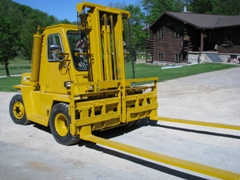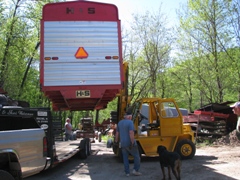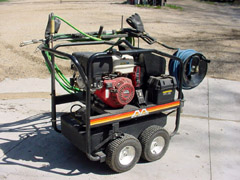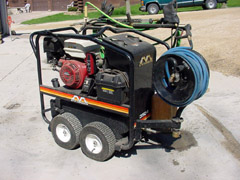Special Tools Overview
Our business is unique so we have developed special tools to fit the individual needs. One of the biggest problems people face after having a forage box wrecked can be how to unload, retrieve, and set up the unit. Wrecks don’t happen to empty boxes on a flat open field. In 25 years we have seen boxes in every imaginable situation. Often the chopper boxes are in these situations while sitting full of silage. That means you face two separate problems, unloading the box and getting the box out of whatever situation it is in. Over the years we have become quite efficient at this by developing custom tools for these tough cases. These tools keep changing as we find what works the best. We also have other tools that save time and produce the best final solution.
Caterpillar V120 Forklift
We use this 10-ton (20,000-pound) forklift to transition chopper boxes from any trailer or truck. This forklift can lift a chopper box up to 12 feet off the ground, making the transition of the box to our facilities an easy process. Due to the 12,000-pound lifting capacity, changing boxes from your trailer to our repair shop is a safe and easy process. The tines are 9 feet long allowing them to go completely under the box making it stable throughout the process. The machine comes with a double side shift, for safety reasons. This means that either tine can move independently of the other. The entire mast (front of the forklift) of the unit can shift up to a foot either way, which makes the boxes easy to unload.


Honda 650 Rubicon Four Wheeler
Used in recovery work to haul tools and recovery equipment. Has a Warn 2,000-pound winch to help pull cables and chains down to the wrecked boxes.
![]()
![]()
13 Horsepower Honda Model 3500 Power Washer
This unit uses diesel-heated hot water to wash the silage, grease, and mud from your forage box. There are so many reasons that it is smart to clean a forage box, not the least of which is that our customers are always happy to have that new chopper box smell. We clean every box with any major work before we start the rebuild process. Why would we do this you ask? Well for one thing we can spot issues and defects with the box much easier. For instance, cracks in the steel, loose bolts, out-of-adjustment webs or chains, or any other moving parts.
Having a clean box allows us to work much quicker. We can diagnose problems quicker, it is easier to find fittings, bolts, and especially master links on the head. If you were to clean as you go using wire brushes or scraping you would easily spend much more time on it and possibly miss potential problems. It only takes a few seconds to wash gear hubs, making the packing of wheel bearings much easier. As well as keeping the whole box clean, doing this prepares boxes to get painted once we complete repair work. Every box we sell gets power washed since we care about the final product and it allows you to see everything with your box from the start. The power washer has also proved very useful for our own equipment maintenance.


Portable Power Hydraulic Machine with Honda motor
When a box wrecks it is not always completely disabled. Often the wagon can still run given the right power source. We have seen this more in recent years as hydraulic boxes are becoming more popular whether they be front and rear unload or rear unload only. To help specifically in this situation we designed a remote-controlled, gas-powered, dual-filtered machine. It hooks directly into the hydraulics of the box. The two adapters this machine has allows the web to run backward which will clean out wrecked rear-unload hydraulic boxes. This tool again saves hours of manual work and the associated labor we would otherwise have to charge for this situation. Back at the main operation we also use this machine to test hydraulic boxes after repair.


